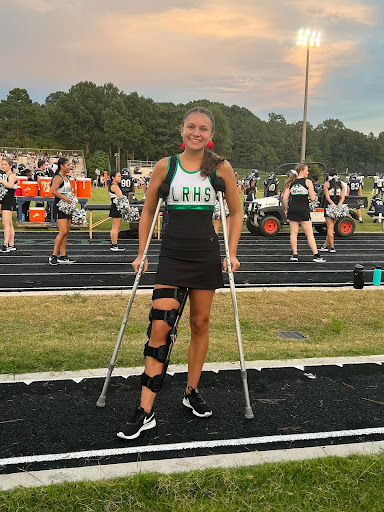5.2 million high school athletes were injured in the United States between 2015-2019 according to research presented at the Academy of Orthopaedic Surgeons last year.
The study found that injury rate is declining in high school sports but injuries themselves are becoming more severe. The most injured body parts were head, ankles and knees. Most injuries occur in football, girls soccer and boys wrestling.
“I have been dancing since I was a little girl since before I can remember…I have injured my knees 5 times and I’ve had 3 surgeries,” said Madeline Carpenter, sophomore.
Muscle, tendon, and growth plate injuries are more common in teenagers because they are still growing.
A big problem experts are seeing is “sports specialization” intensive year round training for a single sport starting at a young age.
Sports injuries are split into two types, acute and overuse. Acute injuries are caused by sudden trauma such as a twist fall or collision. Sprains, muscle strains, dislocations, fractures and concussions are all acute injuries. Overuse injuries are exactly what they sound like. They develop over time from repeated activity without recovery. This includes elbow injuries from overhanging pitching, wrist injuries from gymnastics, and stress fractures in the shin and foot from running.
Lower body injuries like hamstring strains, ankle sprains, and ACL tears are more common in the fall season. Sports like soccer, football, basketball, and cross country involve more running, cutting and pivoting. Students have not been practicing during the summer, so to get players ready for games, coaches do intense conditioning. Increasing the intensity of exercise too quickly definitely contributes to injuries.
Most injuries occur during games but many athletes continue playing. Coaches and parents can look for symptoms like changes in technique or form, limping, breathlessness, headaches and nausea. It is never a good idea to ‘play through the pain’. The adrenaline and endorphins during a game interfere with an athlete’s pain perception. Pushing through will worsen injury or cause permanent damage.
Joint injuries may have no pain swelling, normal range of motion and strength. Injuries with no obvious damage like concussions often go undetected. Which is why it is important to talk to a doctor after any accident and about any pain you may be experiencing.
Doctors look at symptoms, medical history, swelling, bruising, tenderness, and assess range of motion. Further examination may require x rays, CT scans and MRIs.
For overuse and minor injuries use the at home R-I-C-E treatment method.
Rest – Take a break from playing for 2-3 days. Avoid using and bearing weight on the injured body part.
Ice – Apply an ice pack to the injured area for 20 minutes every 2-3 hours during the first 24 hours of injury.
Compression – prevent swelling by wrapping the injury preferably with an elastic medical bandage. Be careful though too much pressure can cut off circulation.
Elevation – Keep the injured ankle, knee, elbow or wrist elevated on a pillow above the level of your heart to reduce swelling.
You may also use over the counter anti-inflammatory drugs like ibuprofen and aspirin to relieve pain, fever and inflammation.
The vast majority of sports injuries heal on their own and athletes can return to playing within a couple weeks. Broken bones and torn ligaments on the other hand require surgery and their recovery spans months. After surgery the injured body part will be immobilized with a brace, cast, sling or boot. Patients are also prescribed physical therapy, exercises and treatments to relieve pain and improve range of motion.
“This year, we had 3 ACL injuries and multiple sprained ankles..we lost many players in the same position…we don’t wanna overload them. We schedule lifting so it isn’t all at once,” said Ben Kolstad, Head Football Coach.
“We take warm up, cool down and recovery very seriously… it takes at least 10 minutes for muscle capillaries to open up and 5 minutes for the knees to totally lubricate,” said Eric Gamble, Cross Country and Long Distance Track Coach.
The best treatment is prevention. Coaches prevent injuries amongst their athletes by training proper technique and providing safe equipment. As for athletes, it’s their responsibility to stay hydrated, eat well and get enough sleep.
“You have to have small goals like walking, squatting and jumping. It’s all about baby steps, focus on the now,” said Madeline Carpenter, sophomore .
For athletes who have already been injured, you can’t change the past, but you can be more mindful in the future. Their advice for students who are currently recovering from an injury is not to be discouraged — if you work hard and be patient you will get back to your sport stronger than ever!


Leave a Reply